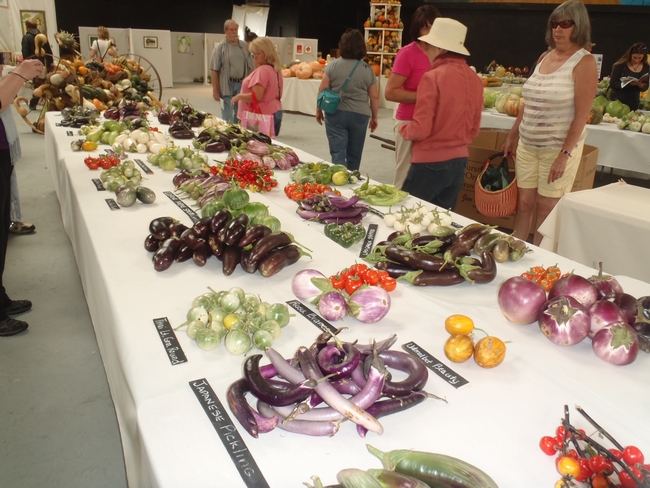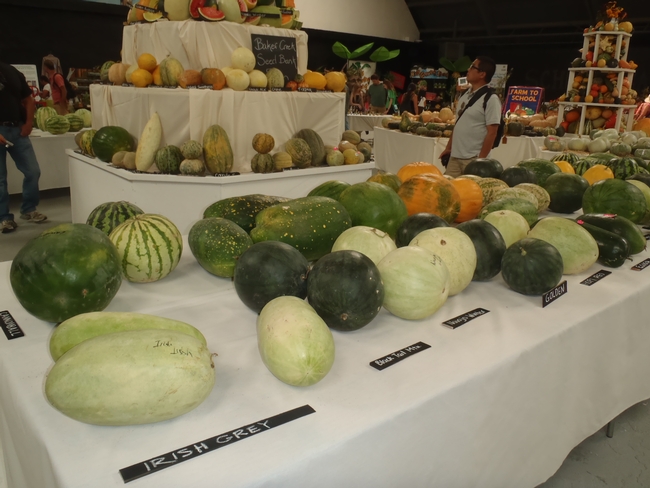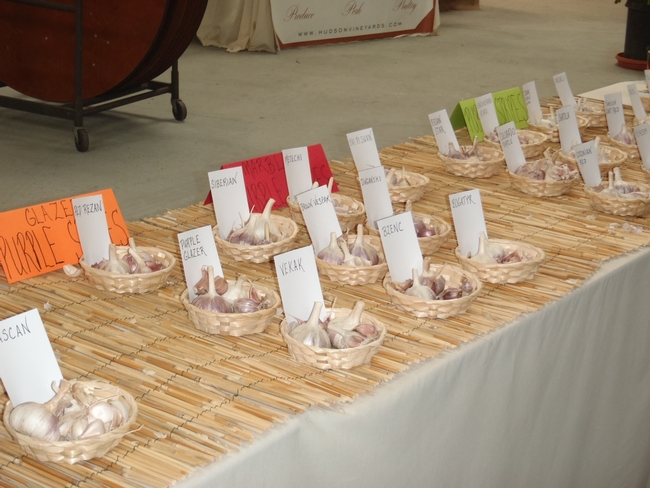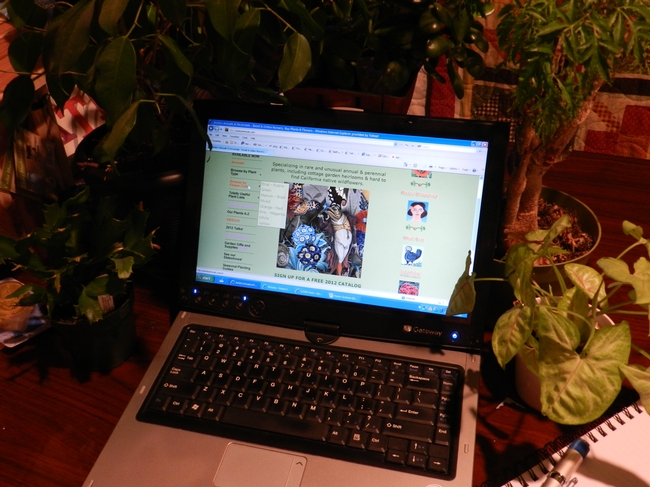Posts Tagged: varieties
2012 Heirloom Expo
For those of you who read my blog entry last year around this time, you know that I had attended the first annual Heirloom Expo at the Sonoma County Fairgrounds in Santa Rosa last year. Having trouble keeping away, I attended the Heirloom Expo again this year on September 11, 2012 (the Expo usually runs for 3 days in early-mid September, from Tuesday to Thursday). It was just as well organized and entertaining, as it was last year. What made it especially memorable this year, was because some of the heirloom vegetables on display were grown and harvested by my former neighbor (see the pics featuring melons and eggplants). To clarify, the Baker Creek Heirloom Seed Company has a research plot just 2 doors down from where I used to live in Suisun Valley, and it is there that they grew umpteen varieties of eggplants and melons which they displayed at the Expo.
One of the vendors at the Heirloom Expo, was Paul Palmer of the Los Olive Homegrown Gourmet Garlic company (aka the “Garlic Guy”) located in the San Ynez Valley, which grows, according to an August 2010 blog post by the company, over 61 varieties of rare garlic (see pics). Check out Paul’s website here-http://www.garlicguy.net/99639385, which contains sample photos of some of the amazing varieties he grows. I spoke with Paul regarding what his secret was to successfully growing garlic, and he told me that he amends his soil with at least 25-30 tons of high quality compost per acre. Now most of us city-dwelling garlic lovers do not have an acre to do what Paul does, but we can take that same principle and scale it down to our backyards (where we can exercise greater control over our growing environment than on a farm) and produce some amazing, beautiful, and rare garlic every year which you can then save and trade with friends and family, and replant each year.
As for me, I grow garlic each year and have found success in growing several varieties such as German Hardneck and Ichelium Red. This year, in addition to the Ichelium Red, I will be planting seed garlic from Paul, varieties which include Spanish Morada (hot), Spanish Benittee (hot), Thai Purple (less hot), Red Razan (medium, all-around variety) and Fabermadour (a baking garlic which, according to Paul, is good for spreads). I will report back the results next June when I harvest!

Many varieties of eggplant. (photos by Betty Homer)

Melon varieties.

Baskets of gorgeous garlic.
Did You Miss This? Part 2
Here I am again thinking about the citrus talk on June 23 at Annie’s Annuals by John of Four Winds Citrus and trying to remember all the details of that great talk. When I last visited with all of you via the Master Gardener Blog, I was discussing his ideas of fertilizing your citrus trees. So here we go again . . .
My last sentence was regarding the use of the fertilizer stakes: John does not recommend them as the stakes can create “hot” spots which can burn the roots. He prefers the liquid fertilizers. However, John advised us that he uses time-release fertilizers in the winter months, right up to Thanksgiving. This is a stressed point: Always go into a freeze watered. Water the ground around the tree for the best protection. Keep the citrus trees hydrated during the cold, especially if the temps are going to hit the mid to low teens as a dry, un-watered tree is the most susceptible to the cold. The rule of thumb: the more cold-sensitive the citrus, the faster it grows --- The more cold-hardy the tree, the slower it grows. Goody for our teams who have the slower growing trees! John didn’t tout very many named products, but he did mention “frost bonnets” which Four Winds carries in 3 sizes. Also the use of Christmas lights (the old, warm kind not the new LEDs) can keep the frost at bay; or, just use bubble wrap. Just remember to remove during the day.
Always know where the graft is on your citrus trees. Remember, that all the growth below that graft is root stock! To find the graft, check the trunk of your tree to find the slightly thicker area which is the graft. Some grafts will be vertical like (a V), some grafts will be horizontal around the truck (which can make for a less hardy graft if the tree grows on one side much more than the other.
All citrus have thorns, some varieties more than others. Thorns are NOT a sign of suckers! Only remove the growth below the graft lines to control suckers. Red or purple new growth on lemons equals good fertilizing habits. Too much nitrogen equals leggy, spindly growth.
Some of John’s “per says”:
- Remove all sucker growth.
- Remove growth touching the ground; this allows air circulation inside the canopy of the tree.
- What pruning needs to be done is for strictly cosmetic or looks and is just elective. Citrus trees really don’t need pruning except in case of a broken limbs.
- Removing the “water sprout” (straight upward growth of leaf-bearing stems) doesn’t need to be done unless those branches are keeping lights from inside the tree.
- Don’t worry about crossing limbs – that’s the way citrus grow.
- Remove too many limbs and branches, and sun burn/sunscald can occur on the trunk and larger branches.
- DO NOT pinch the tips on citrus; this will merely result in a tree that has the “pom pom” look.
John advised that the Four Winds website has links to pests, diseases, and products which deal with both. As pesticides, he recommends the following: Orange Guard by TKO; Safer Soap products; and horticultural oil. For ants, Four Winds uses Terro (the product name); Boric acid, and of course IPM (Integrated Pest Management): easiest way to remove scale is blast of water hose – this is also good for aphids. John personally uses his thumbs to remove both scale and aphids or a pencil for to pry larger scale off. This last is not for the squeamish, but effective.
Remember when fertilizing citrus during the warm months that citrus pull fertilizer from the drip line, so piling on the selected fertilizer around the trunk isn’t too helpful. You can use granular fertilizers at 60 degrees and above, but suggest liquid for the rest of the year-round applications.
John has his favorite for the home grower: for an orange, he picked the ‘Washington Navel’ as a hardy, easy-to-grow tree; for the mandarin, he favors ‘Gold Nugget’ which not only ripens in the Spring but is quite cold hardy (mine got zapped in the cold but recovered very nicely and didn’t have much die-back). Lemon, he likes the ‘Meyer’; the grapefruit, he selected ‘Oro Blanco’, but advised that the ‘Rio’ (red)
might be better for those who prefer red grapefruit. Limes, he preferred. the ‘Bearss’ as the best for California gardens. The “Kaffir Lime” is recommended for those who cook and eat Near Eastern cuisine. Did you know that the leaves from the “Kaffir Lime” can be frozen for use later?
Another citrus he mentioned for the home grower is the ‘Yuzu’, an acidic citrus with highly aromatic, bumpy rind. Both the juice and peel are prized additions in Asian cooking, especially for ponzu sauce. This tree is extremely hardy into the high teens. It can be used from green rind to yellow color. Be warned, this tree has large thorns and is rangy in appearance.
When deciding what to plant, remember to plant just enough for your family to eat. Also plant trees that produce what your family will eat. It’s not cool to have a ton of fruit rotting on the ground that no one will eat or give to others. Speaking of picking citrus, John suggests that we cut the fruits from the tree leaving them with a short stem, that way the fruit will last longer indoors and the tree can keep its smaller branches intact.
The rest of this blog will be the answers to questions that were asked toward the wind-down of the talk:
- If there no fruit on the tree or no blossoms: You may be carefully nurturing rootstock or, most commonly, the fertilizer doesn’t contain the trace elements required by citrus –check the label.
- “Sour lemons”: 99.99% of the time the tree is merely lemon rootstock.
- Fruits dropping: Citrus will self-thin fruits; if the fertilizer lacks the proper Phosphorus (P) or Potassium (K), more pea-sized fruits will drop.
- A red grapefruit that is not sweet is probably a ‘Ruby’ which needs more heat than our area can give.
- Deer don’t like citrus, but rats do!
- Too hot fertilizer will show up at burnt leaf tips.
When a freeze is near – DO SOMETHING!! Anything: Water, cover, or both!
'Meyer' lemons always shed leaves throughout the year. Not to worry. Again, thorns are natural on citrus trees. If you don’t like getting stuck, you can break or cut them (carefully), the thorns will not grow back.
Fruit color is not a clue to the ripeness of the fruit. The color is actually dependent on the coolness of the nights. Ripe citrus develop a natural carnauba wax coating – look for a waxy sheen on the ripened fruit. Dig up citrus for transplanting in the spring. Paint the trunk of the tree with either a white or light-colored latex paint to prevent scald or sun burn on the trunk. Citrus trees don’t cross pollinate, they are self pollinating, so that a single citrus tree can be alone in the yard.
If the fruits on your citrus tree are distorted then: Congratulations, you probably have citrus bud mites!
When to repot a citrus tree in a pot when the roots are peering out the drainage holes.
Repotting per the industry standard:
- A 5 gallon tree into a 7 gallon pot
- A 7 gallon tree into a 15 gallon pot
- A 15 gallon tree into a 24 inch pot
- A 24 inch pot into a ½ wine barrel
Remember to disinfect your pruners between root prunings, 10 parts water to 1 part bleach. And the final line from John: “use “el cheapo” water meters before watering; it is a good learning tool for the developing your water common sense”. Never leave in the pot or the water meter will die a premature death!
His word on HLB or Citrus Blight: by the time you notice it, your tree is already gone! See what you missed!
Techy Gardening Sites
I love technology. It’s amazing what you can learn! I thought I’d give you a review of a couple of websites I’ve been perusing during the “indoor” months. I’m sure there are hundreds out there but it’s easy to get caught up playing with the tools on one site and hardly ever move on to another, but there is just SO much out there. I tried to include a couple “big” companies and a couple smaller local ones. It should be noted though, just because I review it doesn’t mean the UC Master Gardeners endorse or support the business in anyway.
Many seed companies have sites. Burpee (http://www.burpee.com) is one I enjoy because of the sheer variety of plants available and the information. You can see the most up-to-date hybrids and beautiful photos of ripe, mouth-watering veggies. You can type in your zip code for your planting zone and a planting calendar. You can also view their entire catalog online.
Annie’s Annuals (http://www.anniesannuals.com) is always a favorite with her unusual plant varieties and great descriptions given in a fun and familiar way. You can even make a wish list for those you want to purchase or just put in your imaginary perfect garden. She has an email sign up, as do all the rest, and she’ll keep you informed of new varieties and any specials she might have. The artwork itself is enough reason to visit her site.
Home Depot actually has a pretty nice Garden Club. Whether or not you choose to support the “big orange box” or not, they do have a couple nifty features and will send you coupons to your email (as will all the others). They have the plant identifier, while I found it a bit limited, it is great for the home gardener or when one of us “master’s” just can’t remember. They also have a feature where you can save your “plant tags”, like the ones that come in your six-packs of annuals, in your own file. Even if you have some plants in your yard that are growing from previous years, you can still look up the plant and enter it your file. They also have a nifty place where you can store your own photo album, or publish a picture for all in the “garden club” to see, or ask a question such as “what in the world is this plant?”.
Territorial Seed Company (http://www.territorialseed.com/), has their full catalog available online in pdf version. That is short for Portable Document Format, although I think it to mean Pretty Darn Fast when you compare it to regular mail. So it does give you something to peruse while your waiting for your hard copy (that’s computer speak for the old paper and print version;)
They also have a few videos about planting. They also have an Garden Planner, you’re supposed to be able to plot your garden and track it and arrange it and so on, but at $25, even thought they promise a 30-day free trial, my pocketbook found a buck-fifty and a good ol’ piece of paper the best way to plan for now.

Screen shot of Annie's Annuals site. (photo by Patricia Brantley)

